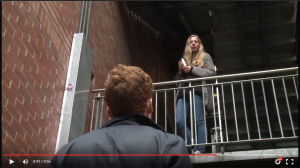Today we did a practical exercise focusing on eye-lines and making sure they are aligned correctly.
It involved a short scene in which two characters face each other and exchange a few lines. We were to capture a wide two shot to establish the physical relationship between the two characters and allows an extended silence that opens the scene. We also capture a clean MCU of Chloe for her line and a clean Mid-shot of Colin for his reply.
We position the actors optimally for Shot 1 but reposition Chloe for her MCU to take best advantage of elements such as lighting. In addition we were to shoot Colin’s Mid-shot in an entirely different space altogether, being careful to match the space, lighting and eye-line.
Ideally we were to learn the difficulty of repositioning actors and the camera while maintaining matching eye-lines. Furthermore, we were to learn that we can move the actors to get the best shot without ruining contunity. The excercise didn’t quite go to plan with the class seeming to get confused and go off-track a bit. Anyway I think most of us got the point and learnt from it regardless. As filmmakers manipulate exactly what the viewer sees and if we do this correctly then a simple scene of two people talking in a room dosen’t have to all be shot in the one room. We might choose to shoot part of a scene in different location due to lighting, something distracting in the background or maybe we have just ran out of time and will need to shoot the rest in the studio.
If eye-lines aren’t matched correctly in a scene its easily noticable and can ruin the whole viewers experience, so it’s important to get right. I find it best to always have the actor or object that isn’t in shot that the person is looking at physically there. What I learnt in my scene anaylsis of Silence of the Lambs is that eye-lines also have creative meaning within in the film. For instance when Hannibal gains power in the scene he looked directly down the barrel of the camera whereas looks off-camera, as she is off-balanced.



